As you set up your home recording studio in 2025, you’ll find 15 standout audio interfaces that elevate your audio production. These cutting-edge interfaces feature 24-bit/192kHz converters, low-latency monitoring, and seamless connectivity across Windows, macOS, iOS, and Android. Whether you’re a seasoned musician or budding creator, you’ll discover the perfect interface to capture professional-quality audio. To dive deeper into the top options and their key features, keep reading.
Key Takeaways
- High-resolution 24-bit/192kHz audio conversion, low-latency monitoring, and a range of connectivity options for a seamless home studio experience.
- Compact, durable, and bus-powered designs that provide professional-grade audio quality and versatility for mobile or desktop setups.
- Comprehensive software bundles, including DAWs and plugin suites, that streamline the recording and production workflow for home users.
- Robust cross-platform compatibility with Windows, macOS, iOS, and Android devices, ensuring compatibility with a wide range of home studio setups.
- Versatile input and output options, such as XLR microphone inputs, line-level inputs, and instrument-level inputs, to accommodate diverse recording needs.
Focusrite Scarlett Solo 3rd Gen USB Audio Interface
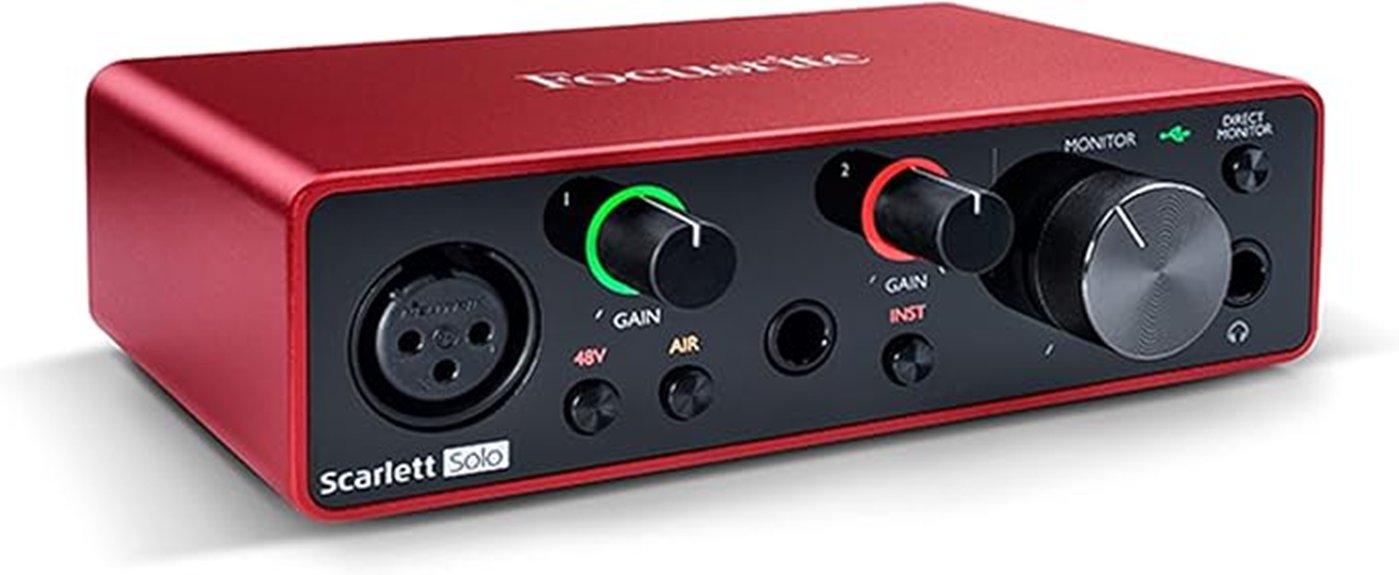
If you’re looking for a simple, yet high-quality audio interface to kickstart your home recording studio, the Focusrite Scarlett Solo 3rd Gen USB Audio Interface is an excellent choice. With its 24-bit/192kHz AD-DA converters and upgraded 3rd-gen Scarlett mic preamp, you’ll enjoy crisp, professional sound quality. The high-impedance, high-headroom instrument input is perfect for guitarists, while the balanced outputs provide noise-free audio playback. Plus, the included software bundle, featuring Ableton Live Lite and Avid Pro Tools Intro+, gives you an all-encompassing toolkit to start recording. Compact, lightweight, and USB-powered, the Scarlett Solo is ideal for on-the-go use, making it a versatile option for vocalists, podcasters, and home studio enthusiasts alike.
Best For: The Focusrite Scarlett Solo 3rd Gen USB Audio Interface is best for vocalists, guitarists, podcasters, and home studio enthusiasts looking for a simple, high-quality recording solution.
Pros:
- Delivers crisp, professional sound quality with 24-bit/192kHz AD-DA converters
- Compact and lightweight design suitable for on-the-road use
- Includes a comprehensive software bundle to get you started
Cons:
- Limited to a single input and output
- May not have enough features for more advanced users
- Requires additional equipment like microphones and headphones for complete setup
https://www.amazon.com/dp/B07QR6Z1JB
M-Audio M-Track Duo USB Audio Interface
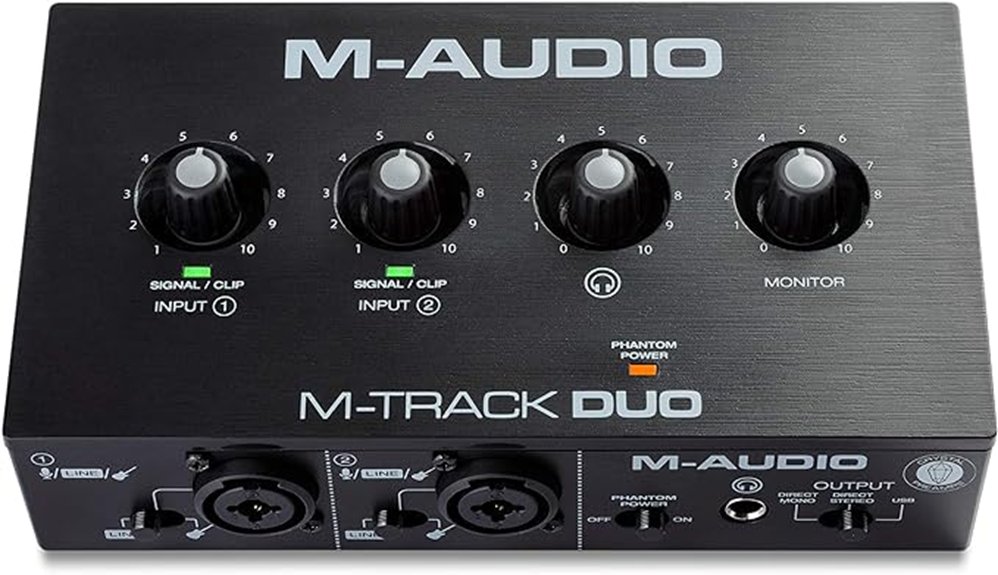
The M-Audio M-Track Duo is an excellent choice for aspiring home recording enthusiasts seeking a versatile and user-friendly audio interface. With its dual XLR, line, and DI inputs, you can seamlessly connect a variety of microphones, instruments, and audio sources. The included MPC Beats software further enhances your creative workflow, allowing you to record, edit, and produce your tracks with ease. The M-Track Duo’s portability and USB-powered design make it an ideal companion for on-the-go recording sessions. With its crystal preamps and zero-latency monitoring capabilities, you’ll enjoy professional-grade audio quality without the hassle of complex setups.
Best For: Aspiring home recording enthusiasts who want a versatile and user-friendly audio interface.
Pros:
- Dual XLR, line, and DI inputs for connecting a variety of audio sources
- Included MPC Beats software for enhanced creative workflow
- Portable and USB-powered design for on-the-go recording
Cons:
- Limited to 48 kHz audio resolution, which may not be sufficient for some professional applications
- Relatively low number of input/output channels compared to higher-end interfaces
- Potential compatibility issues with certain software or operating systems
https://www.amazon.com/dp/B08Q1V77NR
USB Audio Interface for PC and Mac Recording Music
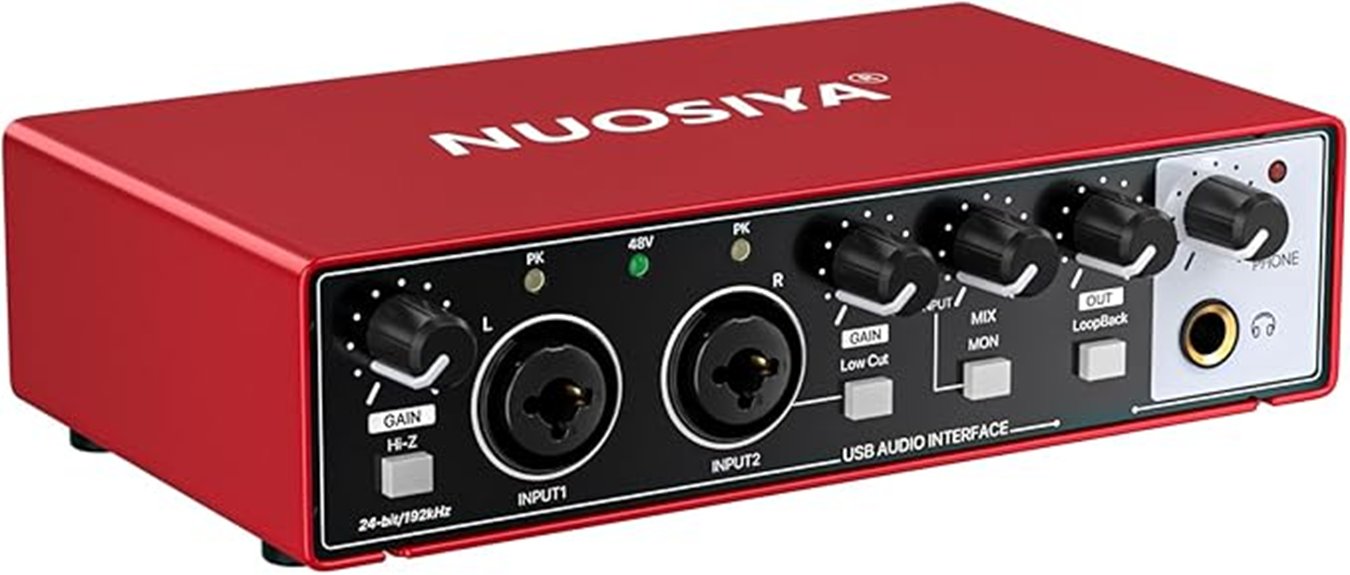
A USB audio interface is an excellent choice for those who want to elevate their home recording studio setup. This compact and portable device offers studio-quality audio, enabling you to capture clear, detailed recordings for your music, podcasts, or live streams. With support for 24-bit/192kHz recording, you can guarantee your audio retains every nuance. The interface’s versatile inputs accommodate both instruments and microphones, while the phantom power feature allows you to use high-quality condenser mics. Intuitive controls, including independent headphone volume, make monitoring a breeze. Plug-and-play compatibility with Windows and macOS further streamlines the setup, allowing you to focus on your creative process.
Best For: This USB audio interface is best for musicians, podcasters, streamers, and anyone looking to elevate their home recording setup with studio-quality audio.
Pros:
- Supports 24-bit/192kHz recording for pristine audio quality
- Versatile input options for instruments and microphones
- Compact and portable design for use in various settings
Cons:
- May not offer as many advanced features as higher-end professional interfaces
- Phantom power may not be sufficient for some high-gain condenser microphones
- Limited to 2 input/output channels, which may not be enough for more complex setups
https://www.amazon.com/dp/B0CD6ZF7RV
FIFINE Gaming Audio Mixer (Streaming RGB PC Mixer with XLR Microphone Interface)
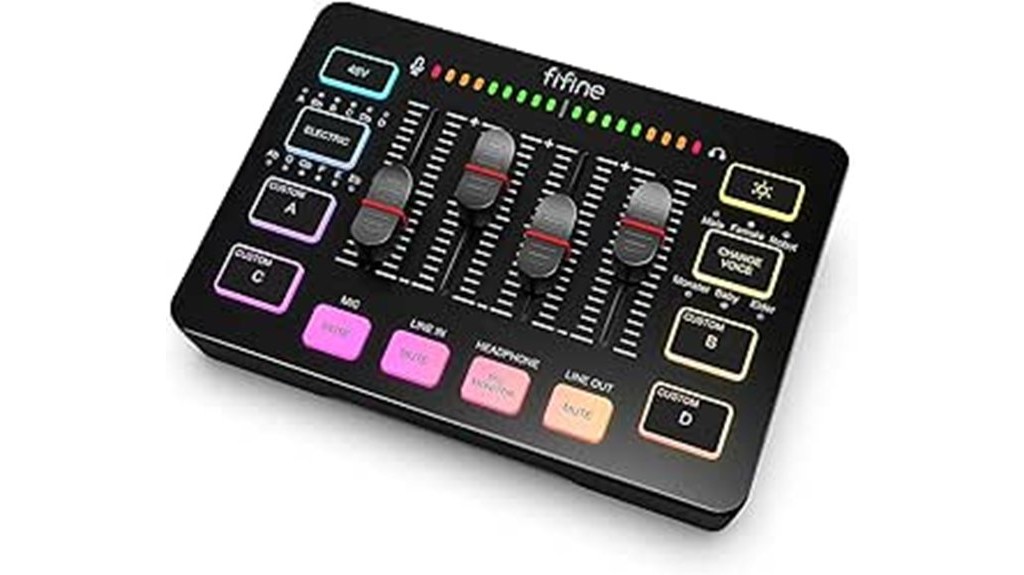
For those seeking a versatile audio mixer for their home recording setup, the FIFINE Gaming Audio Mixer is a compelling option. This RGB-lit mixer boasts individual volume controls for your mic, line-in, headphones, and line-out, as well as mute and monitoring capabilities. The four customizable sound effect buttons and 6 voice-changing modes add creative flair to your productions. With its XLR microphone input and 48V phantom power, the FIFINE caters to professional-grade XLR mics. Its compact, portable design and plug-and-play functionality make it an ideal choice for streamers, podcasters, and gamers alike.
Best For: The FIFINE Gaming Audio Mixer is best for streamers, podcasters, and gamers seeking a versatile and feature-rich audio mixing solution for their home recording setup.
Pros:
- Provides individual volume control and mute/monitoring capabilities for various audio inputs and outputs
- Offers creative sound effects and voice-changing modes to enhance productions
- Supports professional-grade XLR microphones with 48V phantom power
Cons:
- XLR microphone cable is not included, requiring an additional purchase
- RGB lighting may not be desirable for all users
- Some users may find the compact design limiting in terms of physical controls and customization options
https://www.amazon.com/dp/B0BZP95YB5
EBXYA 2i2 USB Audio Interface for PC Recording (Metallic Black)
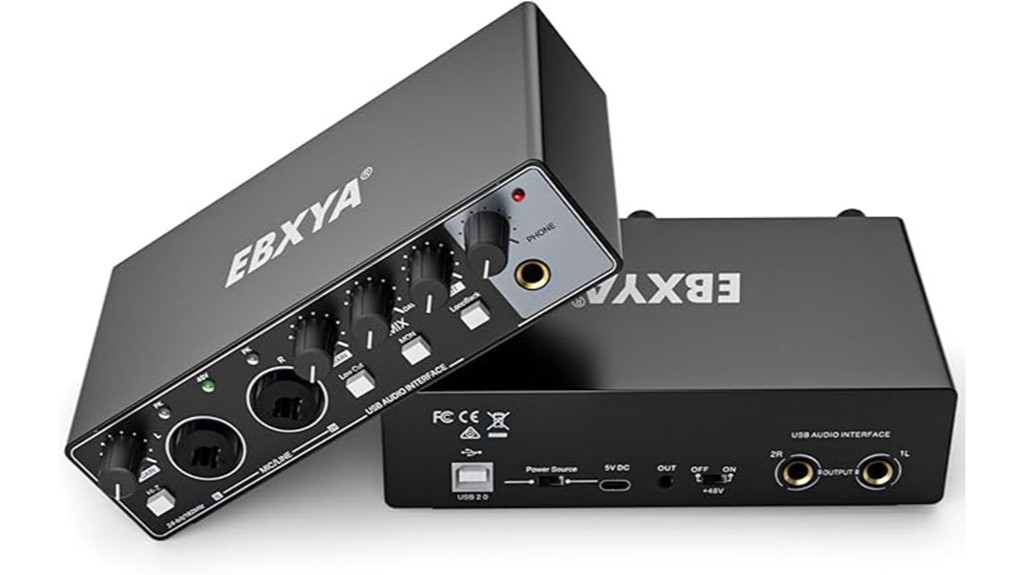
Seeking an affordable yet capable USB audio interface to elevate your home recording studio, the EBXYA 2i2 delivers a winning combination of studio-quality performance and intuitive functionality. With its 24-bit/192kHz resolution and ultra-low latency, it captures your audio with crystal-clear clarity. The flexible dual XLR/line combo inputs accommodate both microphones and instruments, while the HI-Z switch guarantees optimal impedance matching. Phantom power support empowers your condenser mics, and the balanced TRS outputs drive your studio monitors with precision. Compact and portable, the EBXYA 2i2 is a versatile companion for music, podcasting, and streaming, backed by a 2-year premium warranty.
Best For: The EBXYA 2i2 USB Audio Interface is best for musicians, podcasters, and streamers seeking an affordable, high-quality audio interface with flexible connectivity and studio-grade performance.
Pros:
- Clear, studio-quality audio recording up to 24-bit/192kHz
- Dual XLR/line combo inputs accommodate microphones and instruments
- Phantom power support for condenser microphones
Cons:
- No included software or digital audio workstation (DAW)
- May require additional adapters for certain setups
- Limited to 2 input/2 output channels
https://www.amazon.com/dp/B0B81MZ5DJ
PreSonus AudioBox 96 25th Anniversary USB Audio Interface with Studio One Artist DAW Recording Software
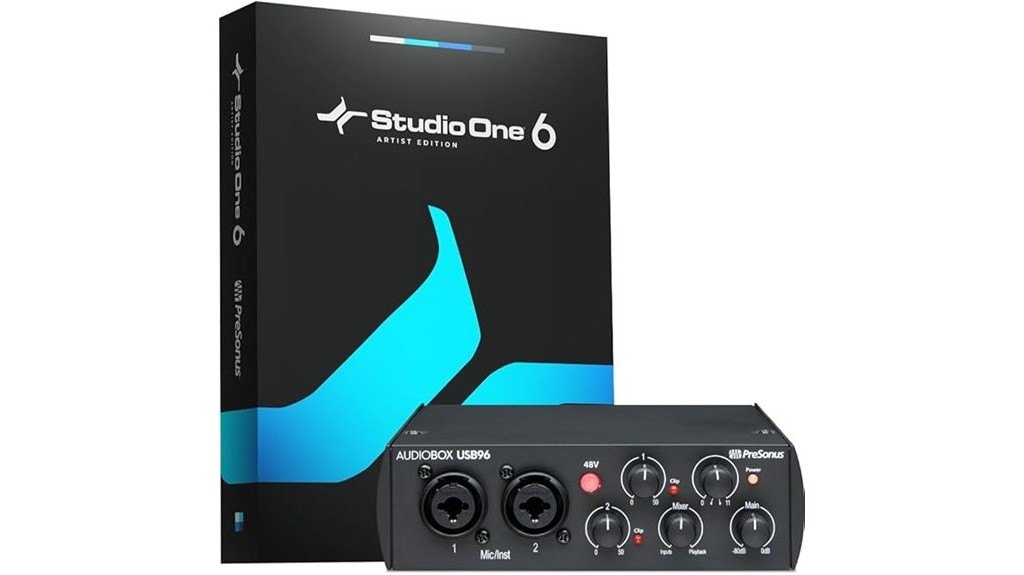
The PreSonus AudioBox 96 25th Anniversary USB Audio Interface is the ideal choice for the aspiring home recording enthusiast. With its two high-quality Class-A mic preamps and two high-headroom instrument inputs, you can easily record your guitar, bass, and other line-level devices. The studio-grade converters allow for up to 24-bit/96 kHz recording and playback, ensuring exceptional audio quality. The heavy-duty steel chassis makes it durable for mobile recording, while the USB bus-powered design eliminates the need for an additional power supply. Plus, you’ll get over $1000 worth of recording software, including the powerful Studio One Artist DAW, to kickstart your home studio journey.
Best For: The PreSonus AudioBox 96 25th Anniversary USB Audio Interface is best for aspiring home recording enthusiasts looking for a portable, high-quality, and feature-packed audio interface.
Pros:
- Exceptional audio quality with up to 24-bit/96 kHz recording and playback
- Durable, heavy-duty steel chassis for mobile recording
- Includes over $1000 worth of recording software, including the powerful Studio One Artist DAW
Cons:
- Limited to 2 input channels, which may not be enough for more complex recording setups
- Requires a computer or mobile device for operation, limiting its standalone functionality
- May not have all the advanced features and customization options found in higher-end audio interfaces
https://www.amazon.com/dp/B08D8R6VFC
MAONO USB Audio Interface for PC (PS22 Lite Black)
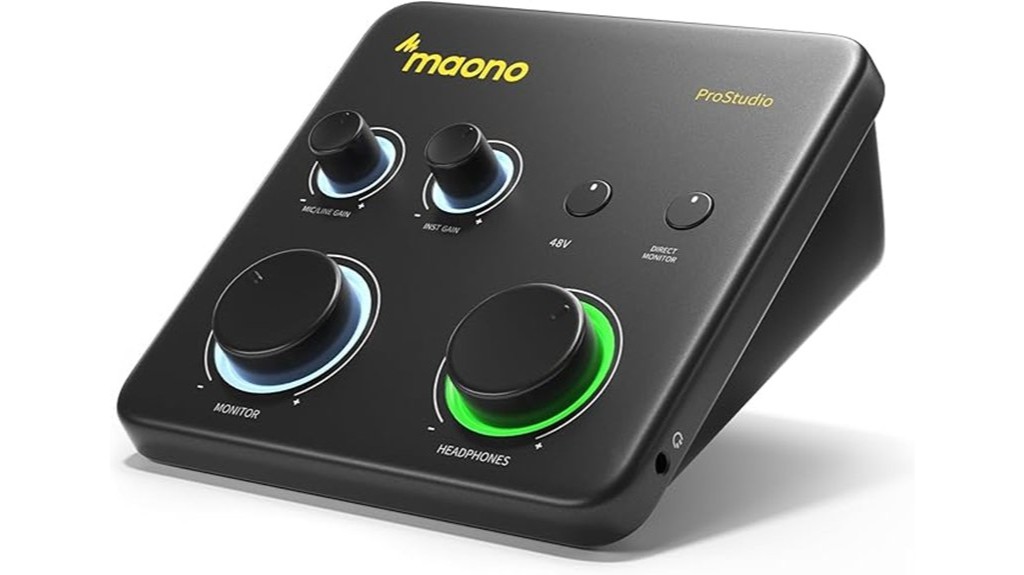
If you’re looking for a user-friendly and versatile USB audio interface to elevate your home recording setup, the MAONO PS22 Lite Black is a compelling option. Its plug-and-play design guarantees immediate PC recognition, while the intuitive layout of controls simplifies tasks like gain, volume, and essential functions – perfect for beginners. Beyond its ease of use, the PS22 Lite boasts impressive versatility, with an XLR input for professional microphones and the ability to switch between different audio sources. Enjoy high-resolution 24-bit/192kHz recording and a dynamic range of 106dB for clear, realistic sound, thanks to the well-designed preamp. The included LOOPBACK software and ASIO driver support further enhance your workflow, making the MAONO PS22 Lite a reliable companion for your home studio needs.
Best For: The MAONO PS22 Lite Black USB Audio Interface is best for home studios, podcasting, streaming, and music recording enthusiasts who want a user-friendly and versatile audio interface.
Pros:
- Plug-and-play setup with immediate PC recognition
- Intuitive layout of controls for easy operation
- High-resolution 24-bit/192kHz recording and 106dB dynamic range
Cons:
- Limited to one XLR input, which may be limiting for some users
- No MIDI input/output capabilities
- May require additional software for more advanced features
https://www.amazon.com/dp/B0D9P3Y22C
FIFINE PC Audio Mixer for Recording Music
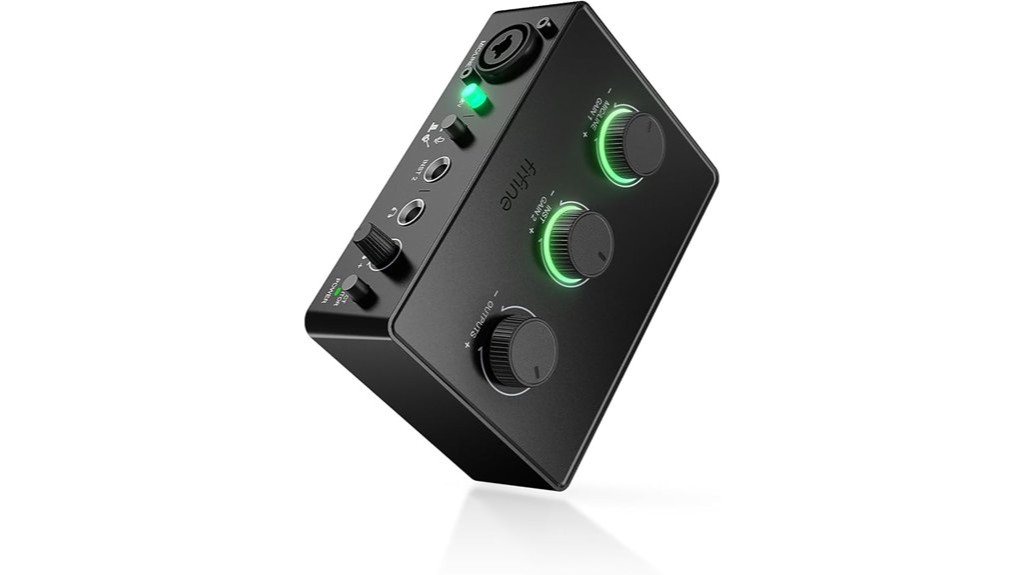
For those seeking an extensive and user-friendly audio mixer for their home recording studio, the FIFINE PC Audio Mixer delivers exceptional performance. With its improved sound quality, the mixer offers one XLR microphone interface and one instrument interface, providing studio-level capture for podcasting. The XLR microphone interface includes 48V phantom power, allowing you to utilize high-quality condenser mics, while the intuitive mic gain knob lets you fine-tune input levels. The dedicated instrument input accommodates guitars and basses, and the audio output features a separate volume knob for precise playback control. The direct monitoring function with a dedicated volume knob enables real-time monitoring of your recordings. Compatible with both Mac and PC, the FIFINE PC Audio Mixer’s plug-and-play functionality guarantees seamless integration into your home recording setup.
Best For: The FIFINE PC Audio Mixer is best for home recording enthusiasts who want a high-quality, user-friendly audio interface for podcasting and music production.
Pros:
- Improved sound quality with XLR microphone and instrument inputs
- Includes 48V phantom power for use with condenser microphones
- Intuitive controls for fine-tuning input levels and playback volume
Cons:
- Limited to one XLR microphone and one instrument input, which may not be enough for more complex setups
- No built-in audio effects or processing capabilities
- May not provide the same level of professional-grade performance as higher-end audio interfaces
https://www.amazon.com/dp/B0CDZV5ZK3
Universal Audio Volt 1 USB Recording Studio Audio Interface
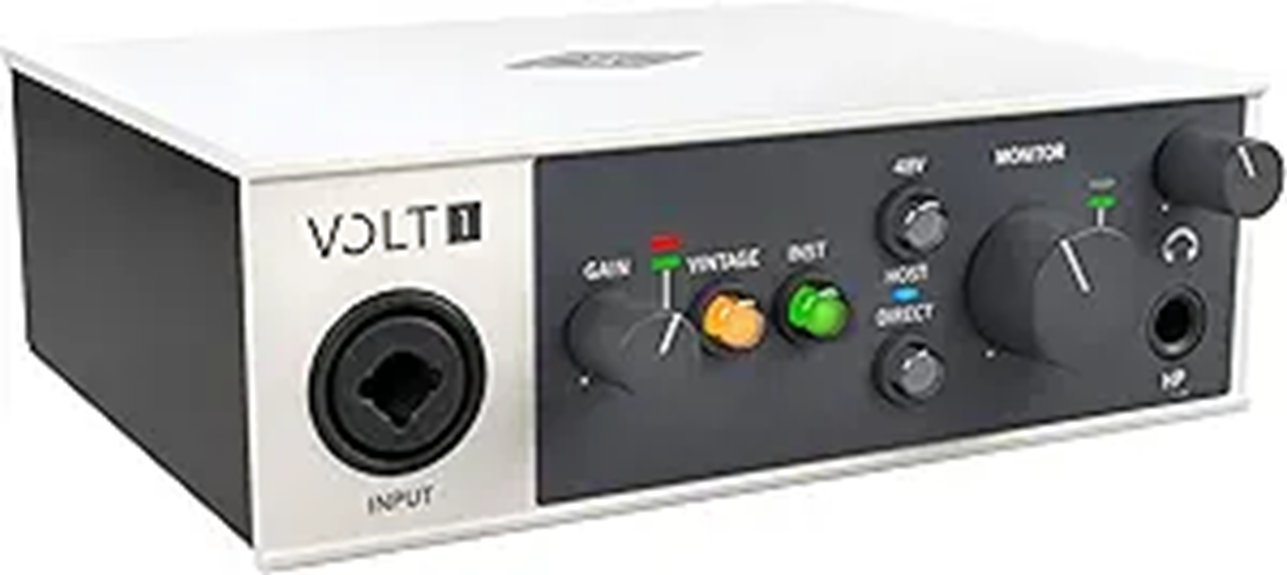
Seeking a versatile and high-quality audio interface for your home recording setup? Consider the Universal Audio Volt 1. This USB interface delivers superior 24-bit/192 kHz sound quality, thanks to its Vintage Mic Preamp mode derived from UA’s renowned 610 tube preamp. The solid construction and sturdy knobs guarantee reliability, while the zero-latency monitoring and direct-drive headphone output enhance your recording experience. Immerse yourself in the included suite of UAD plug-ins and instruments, such as the iconic Teletronix LA-2A and Pultec EQs. Compatible with a wide range of software, the Volt 1 seamlessly integrates into your workflow, whether you’re recording vocals, guitars, or podcasts. At an excellent value, this audio interface is a versatile addition to your home studio.
Best For: The Universal Audio Volt 1 audio interface is best for home recording enthusiasts seeking a versatile, high-quality, and easy-to-use solution for their studio setup.
Pros:
- Exceptional sound quality with up to 24-bit/192 kHz resolution
- Includes a suite of valuable UAD plug-ins and instruments
- Sturdy construction and reliable performance
Cons:
- May be overkill for basic home recording needs
- Limited input/output options compared to higher-end interfaces
- Requires additional software licenses for full functionality
https://www.amazon.com/dp/B09J1V6R6N
Mackie Onyx Producer 2X2 USB Audio Interface
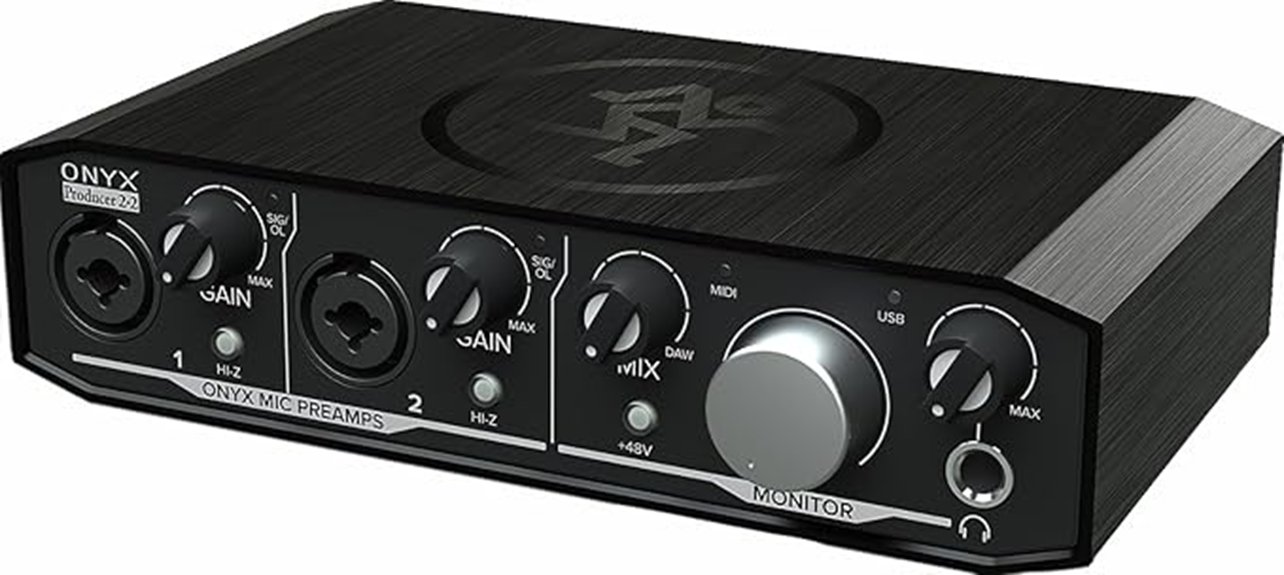
The Mackie Onyx Producer 2X2 USB Audio Interface is an exceptional choice for home recording enthusiasts seeking a durable, reliable, and high-quality interface. Its boutique-quality Onyx mic preamps deliver class-leading fidelity and dynamic range, while the XLR/TRS combo inputs accept a variety of sources. With zero-latency direct monitoring and a powerful headphone output, you’ll enjoy seamless integration with your DAW. The bus-powered USB 2.0 connectivity guarantees fast transfer speeds and low latency, eliminating the need for a separate power adapter. Complemented by The Musician Collection of 23 plugins and instruments, this audio interface is a versatile and well-designed solution for your home studio.
Best For: Home recording enthusiasts seeking a durable, reliable, and high-quality audio interface.
Pros:
- Boutique-quality Onyx mic preamps with class-leading fidelity and dynamic range
- Zero-latency direct monitoring and powerful headphone output
- Bus-powered USB 2.0 connectivity for fast transfer speeds and low latency
Cons:
- May not have as many I/O options as larger, more expensive interfaces
- Limited to 2 in/2 out configuration
- Software bundle may not be a selling point for all users
https://www.amazon.com/dp/B076646D8H
2×2 USB Audio Interface for PC
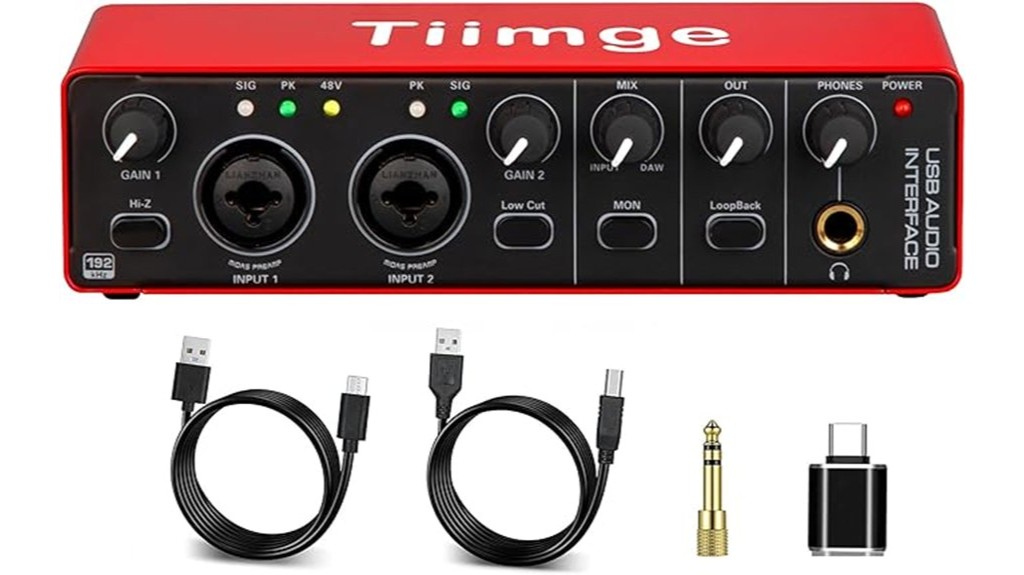
If you’re looking for a reliable and versatile USB audio interface to elevate your home recording studio, the 2×2 USB Audio Interface for PC is an excellent choice. This interface offers 24-bit/192kHz high-fidelity recording, ensuring your audio captures the nuances of your performances. With its 48V phantom power, you can seamlessly integrate condenser microphones into your setup. The versatile input jacks cater to a range of instruments, from vocals to guitars, making it a versatile tool for your creative pursuits. Enjoy the convenience of plug-and-play operation, with compatibility across Windows and Mac OS. Whether you’re using Avid Pro Tools, Ableton Live, or Steinberg Cubase, this interface fits right into your preferred recording software.
Best For: The 2×2 USB Audio Interface for PC is best for home recording enthusiasts and small-scale music producers who require a versatile and high-quality audio interface for their Windows or Mac-based recording setup.
Pros:
- Offers 24-bit/192kHz high-fidelity recording for pristine audio quality
- Includes 48V phantom power for seamless integration of condenser microphones
- Versatile input jacks accommodate a range of instruments and audio sources
Cons:
- May not offer as many input/output options as larger, more professional-grade audio interfaces
- Limited on-board controls and customization options compared to more feature-rich interfaces
- Some users may experience compatibility issues with certain recording software or operating system versions
https://www.amazon.com/dp/B0C85LVNTK
Behringer U-PHORIA UMC404HD 4×4 USB Audio/MIDI Interface

For home studio enthusiasts seeking a versatile, high-quality audio interface on a budget, the Behringer U-PHORIA UMC404HD 4×4 USB Audio/MIDI Interface is a compelling choice. With its audiophile-grade 24-bit/192kHz resolution, four state-of-the-art MIDAS-designed mic preamps, and balanced XLR and 1/4″ TRS main outputs, this interface delivers impressive performance. Its impact-resistant metal chassis, designed and engineered in Germany, guarantees durability. While some users report minor compatibility and phantom power issues, the U-PHORIA UMC404HD is generally praised for its value proposition, making it a strong contender in the home recording market.
Best For: Home studio enthusiasts seeking a versatile, high-quality audio interface on a budget.
Pros:
- Audiophile-grade 24-bit/192kHz resolution
- Four state-of-the-art MIDAS-designed mic preamps
- Balanced XLR and 1/4″ TRS main outputs
Cons:
- Some reported compatibility issues
- Phantom power implementation concerns
- Potential for minor user experience problems
https://www.amazon.com/dp/B00QHURLHM
MAONO Gaming Audio Mixer (MaonoCaster G1 NEO)
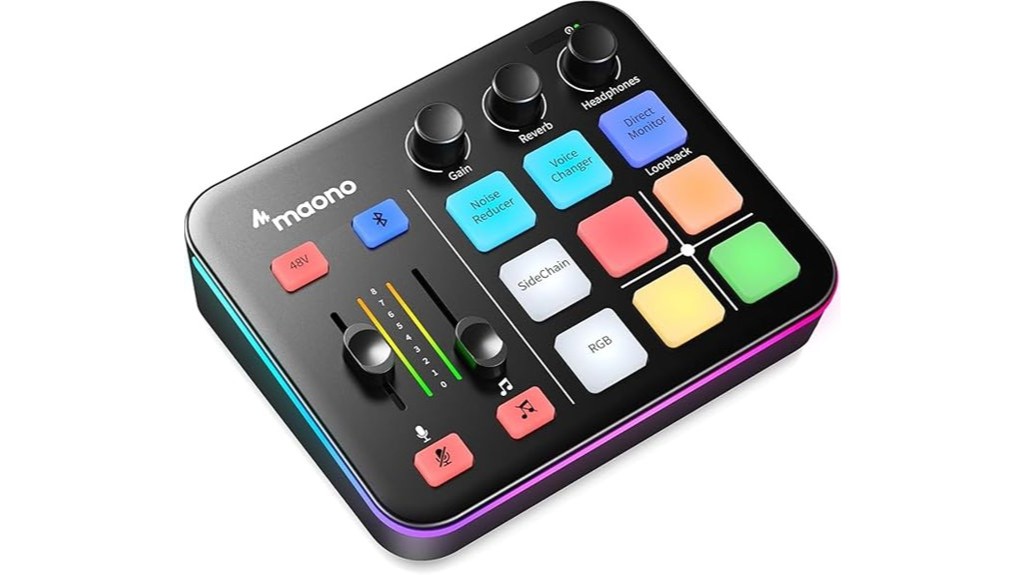
Offering a compelling combination of professional audio features and customizable aesthetics, the MAONO Gaming Audio Mixer (MaonoCaster G1 NEO) is the ideal choice for gamers and up-and-coming streamers seeking to elevate their content creation experience. Its built-in pro-preamp and 48V phantom power activate the potential of XLR microphones, while the voice change feature and custom sound pads add a touch of personality. The intuitive interface and one-click mute, loopback, and direct monitor options streamline your workflow, allowing you to focus on engaging your audience. With 12 vibrant color options and compatibility across devices and platforms, the G1 NEO is a versatile companion for your gaming and streaming endeavors.
Best For: Gamers and up-and-coming streamers seeking a professional-grade audio solution with customizable aesthetics.
Pros:
- Built-in pro-preamp and 48V phantom power for XLR microphones
- Voice change feature and custom sound pads for added personality
- Intuitive interface and one-click controls for streamlined workflow
Cons:
- Not compatible with USB microphones, Xbox, or MAONO devices
- May have a learning curve for users unfamiliar with audio mixing
- Potential for higher cost compared to basic audio solutions
https://www.amazon.com/dp/B0CZDPKPX5
Ueteto Audio Interface for Guitar, Portable Internal Recording Sound Card for Live Streaming
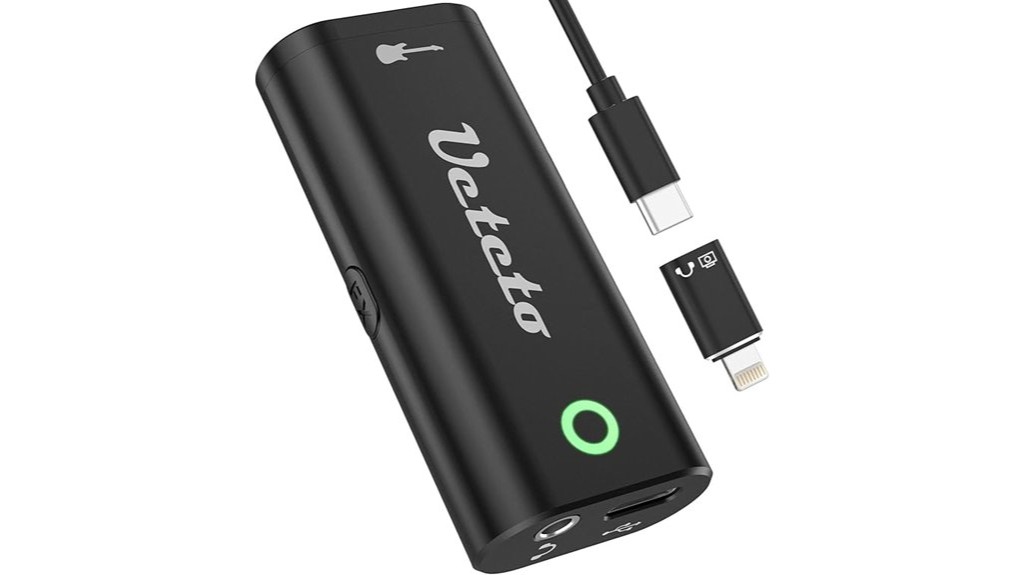
The Ueteto Audio Interface for Guitar is a portable, compact option well-suited for musicians and live streamers who need a simple, plug-and-play recording solution. With its internal recording capability, you can capture your guitar performances directly to your mobile device, eliminating the need for additional software. While it’s not compatible with GarageBand, the Ueteto may work with various apps, though you may encounter some latency issues or compatibility problems. Its hardware features, including a headphone jack and indicator light, provide convenient monitoring and volume control. However, the mixed feedback on the FX button functionality suggests it may not offer the most robust set of features. Overall, the Ueteto is a basic yet functional audio interface for straightforward recording needs.
Best For: Musicians and live streamers who need a simple, plug-and-play recording solution for their guitar.
Pros:
- Portable and compact design
- Internal recording capability for live streaming
- Compatibility with iPhone, iPad, and Android devices
Cons:
- Not compatible with GarageBand
- Potential latency issues or compatibility problems with certain apps
- Mixed feedback on the FX button functionality
https://www.amazon.com/dp/B0D8P7SXYJ
AudioDeluxe Focusrite Scarlett Solo (4th Gen) USB Audio Interface and Waves Musicians 2 Bundle
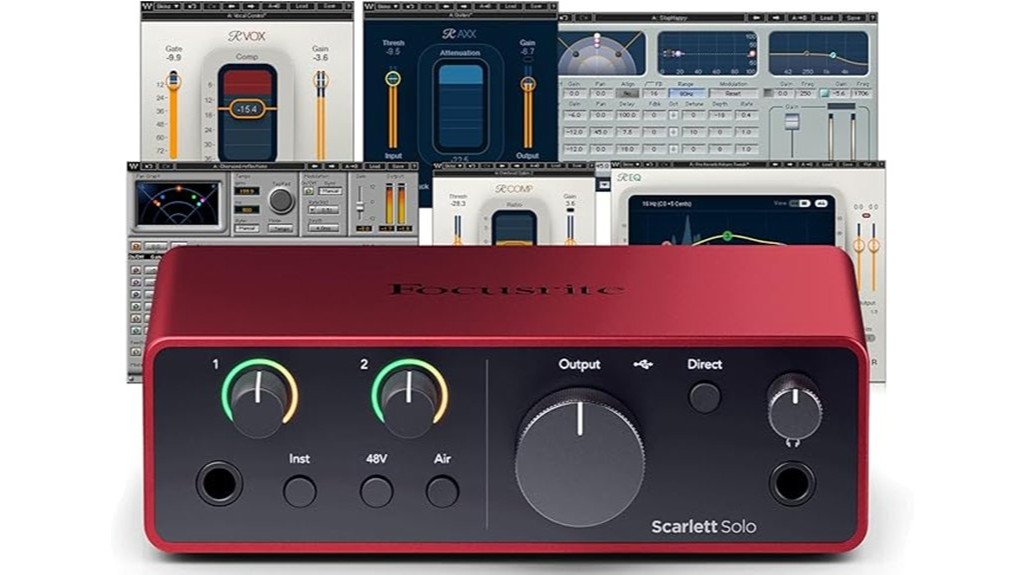
If you’re a solo musician or podcaster seeking a compact, high-quality audio interface for your home recording setup, the AudioDeluxe Focusrite Scarlett Solo (4th Gen) USB Audio Interface and Waves Musicians 2 Bundle is an excellent choice. This exclusive bundle provides professional sound quality with an ultra-low-noise mic pre, studio-grade converters, and 120dB dynamic range. The included Waves Musicians 2 software package offers a range of top-tier plugins, further enhancing your creative workflow. With the Hi-Z instrument input, Air mode, and Hitmaker Expansion bundle, you’ll have the tools to capture your sound with clarity and depth. At just 1.12 pounds, the Scarlett Solo is a portable and versatile solution for your home recording needs.
Best For: Solo musicians or podcasters seeking a compact, high-quality audio interface for their home recording setup.
Pros:
- Provides professional sound quality with ultra-low-noise mic pre, studio-grade converters, and 120dB dynamic range.
- Includes the Waves Musicians 2 software package, offering a range of top-tier plugins to enhance your creative workflow.
- Portable and versatile solution at just 1.12 pounds.
Cons:
- Software bundle may not be necessary for all users.
- Some users may prefer a larger, more feature-rich audio interface.
- Potential compatibility issues with certain operating systems.
https://www.amazon.com/dp/B0CJ15JXFZ
Factors to Consider When Choosing Audio Interfaces
When choosing an audio interface for your home recording studio, you’ll want to examine the audio quality and resolution, the connectivity and compatibility, the available input and output options, the phantom power availability, and the software bundling and support. These factors will help you ascertain which interface best fits your needs and budget. Evaluating these key aspects upfront will guarantee you select the right audio interface for your home recording setup.
Audio Quality and Resolution
Prioritizing high-quality audio resolution is crucial when choosing an audio interface for your home recording studio. Seek interfaces that support 24-bit/192kHz resolution to capture the full dynamic range and fidelity of your audio. The A/D and D/A converter quality immensely impact sound quality, so look for interfaces with low-noise, high-headroom microphone preamps for clean, transparent amplification. The bit depth and sample rate determine the range of audio information you can capture and reproduce, so opt for an interface with a high signal-to-noise ratio to minimize unwanted noise and interference in your recordings.
Connectivity and Compatibility
As you consider audio interfaces for your home recording studio, be sure to check the connectivity options they offer. Look for interfaces with XLR, TRS, and MIDI connections to accommodate your microphones, instruments, and other audio devices. Compatibility with your operating system, including Windows, macOS, iOS, and Android, is also essential. Opt for interfaces that support the desired bit depth and sample rate, such as 24-bit/192kHz, to meet your recording quality needs. Additionally, consider the number of input and output channels the interface provides, and verify if it’s plug-and-play or requires driver installation, which can impact the setup process.
Input and Output Options
The variety of input and output options offered by audio interfaces is a key factor to ponder when selecting the right one for your home recording studio. Whether you need XLR microphone inputs, line-level inputs, or instrument-level inputs, the interface’s connectivity will determine the types of equipment you can connect. Plus, the number of channels, mono or stereo, impacts your recording capabilities. Don’t forget features like phantom power, direct monitoring, and headphone outputs – they can streamline your workflow. And the bit depth and sample rate supported will affect your audio quality. Carefully consider your specific needs to choose an interface that fits your home recording setup.
Phantom Power Availability
When selecting an audio interface for your home recording setup, you’ll want to guarantee it provides phantom power. Many professional-grade interfaces offer 48V phantom power, which is vital for powering condenser microphones and enabling clear, detailed audio recordings. Without phantom power, your microphone options may be limited, and the overall sound quality could suffer. Ensuring your audio interface has adequate phantom power is essential when recording vocals, acoustic instruments, and other sensitive audio sources. Professional-grade interfaces accommodate a wide range of high-quality microphones, so don’t overlook this significant feature when building your home recording studio.
Software Bundling and Support
Beyond the hardware capabilities, many audio interfaces come bundled with software suites that can greatly enhance your overall recording and production capabilities. The quality and selection of these bundled tools – from digital audio workstations to virtual instruments and effects plugins – can profoundly impact the interface’s suitability for your needs, whether you’re a beginner or a seasoned professional. Compatibility with major DAWs is essential for seamless integration, while ongoing software support and driver updates guarantee the interface’s long-term reliability and functionality as the digital audio landscape evolves. Don’t overlook these software-related factors when choosing the best audio interface for your home recording studio.
Portability and Durability
If you frequently travel or need to set up your home recording studio in different locations, portability and durability should be key considerations when choosing an audio interface. Look for lightweight, compact designs that won’t weigh you down. Durable, metal chassis construction can protect your interface against everyday wear and tear, while a rugged, shock-resistant build verifies it can handle the rigors of live performance settings. Bus-powered USB interfaces are especially convenient, as they eliminate the need for a separate power supply, simplifying your setup. Don’t forget to factor in the physical dimensions and weight when selecting a model, confirming it fits your available space and travel needs.
Low Latency Monitoring
Achieving low latency monitoring is essential when selecting an audio interface, as it enables seamless real-time tracking and recording. Low latency is the key to a natural, responsive monitoring experience, pivotal for musicians to play in time and with the right feel during sessions. Interfaces with sub-10 millisecond latency provide a near-instantaneous monitoring, making them ideal for live recording, overdubbing, and other time-sensitive music production tasks. Look for interfaces with efficient digital signal processing, high-performance converters, and optimized software drivers to minimize the time it takes for audio to travel through the interface, ensuring your monitoring feels as immediate as possible.
Value and Pricing
Audio interfaces can range enormously in price, from under $100 to over $1000, with higher-end models generally offering better audio quality, more connectivity options, and more advanced features. When determining your budget, consider not just the interface itself but also any necessary accessories like microphones, headphones, cables, and software. Cheaper interfaces may lack features like multiple inputs/outputs, phantom power, or advanced digital signal processing, so guarantee the feature set matches your needs. Comparing technical specs like sample rate, bit depth, and signal-to-noise ratio can help assess sound quality at different price points. Evaluate the total value proposition, including bundled software and accessories, to determine if a more expensive interface is worth the cost.
Frequently Asked Questions
What Are the Benefits of Using a USB Audio Interface?
Using a USB audio interface offers several benefits. It provides better audio quality than your computer’s built-in sound card, allowing you to capture cleaner, more detailed recordings. The interface also gives you more input/output options, like XLR and instrument inputs, so you can easily connect microphones, guitars, and other gear. Plus, it simplifies the recording process, as the interface handles the audio processing, freeing up your computer’s resources. With a USB interface, you’ll enjoy improved sound quality and more flexible recording capabilities in your home studio.
How Do I Connect My Instruments to the Audio Interface?
To connect your instruments to the audio interface, simply plug the instrument’s output cable into one of the input ports on the interface. Most interfaces have a combination of XLR and 1/4″ inputs, allowing you to connect a wide range of instruments like microphones, guitars, keyboards, and more. Verify the appropriate input gain level on the interface to guarantee a clear, distortion-free signal.
Can I Use the Audio Interface With Both PCS and Macs?
Imagine you’re a musician, hopping between your PC and Mac like a digital nomad. Well, your audio interface’s got your back! It’s a true chameleon, adapting to both operating systems with ease. Plug it in, and boom – you’re ready to record on whichever device suits your mood. No more fussing with compatibility; this interface’s got your creative juices flowing, no matter which tech you prefer.
What Is the Difference Between XLR and 1/4 Inputs?
The main difference between XLR and 1/4″ inputs is the type of signal they’re designed to handle. XLR inputs are for professional microphones and balanced line-level signals, which are less prone to interference. 1/4″ inputs are for instruments like guitars, keyboards, and unbalanced line-level signals. Generally, XLR inputs provide better audio quality, but 1/4″ inputs can work for simpler home recording setups. Choose the inputs that match your gear for the best results.
How Do I Set up the Audio Interface for Live Streaming?
I understand you may be concerned about the complexity of setting up an audio interface for live streaming, but it’s actually quite straightforward. First, connect your microphone or instrument to the appropriate XLR or 1/4″ input on the interface. Then, simply connect the interface to your computer via USB and select it as the audio source in your streaming software. With a few quick steps, you’ll be ready to start broadcasting your amazing live performance.
Conclusion
Prioritize performance, ponder portability, and ponder your preferences to pick the perfect audio interface for your pristine productions. Peruse the plethora of possibilities, ponder the practical applications, and purchase the one that perfectly fits your professional and personal preferences. Produce powerful, polished pieces with the premier audio interface that meets your needs and nurtures your musical endeavors.

Maria is brilliant when it comes to creating beautiful and functional spaces. Maria has an exceptional ability to understand your needs and desires, translating them into tailored solutions that reflect your personality and lifestyle. Whether you’re seeking advice on home decor, looking to upgrade your interior, or seeking inspiration to enhance your quality of life through design, Maria can help you achieve your goals. With Maria by your side, your vision for the perfect home is within reach.
